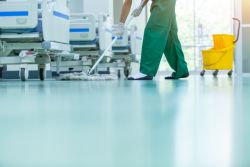Slips, Trips, and Falls
Hospital employees may be exposed to wet floors or spills that increase their risk of slipping or falling. Hospitals are complex work environments often having medical equipment and clutter where employees are working, increasing the potential for tripping and falling.
You can reduce the risk of a slip, trip, or fall by implementing these best practices:
- Keep floors clean and dry [29 CFR 1910.22(a)(2)].
- Provide warning signs for wet floor areas [29 CFR 1910.145(c)(2)].
- Where wet processes are used, maintain drainage and provide false floors, platforms, mats, or other dry standing places where practicable, or provide appropriate waterproof footgear [29 CFR 1910.141(a)(3)(ii)].
- The Walking/Working Surfaces Standard requires keeping all places of employment clean and orderly and in a sanitary condition [29 CFR 1910.22(a)(1)].
- Keep aisles and passageways clear and in good repair, with no obstruction across or in aisles that could create a hazard [29 CFR 1910.22(a)]. Provide floor plugs for equipment, so power cords need not run across pathways.
- Keep exits free from obstruction. Access to exits must remain clear of obstructions at all times [29 CFR 1910.36(b)(4)].
For more information on this topic, see course 624 Healthcare: Slip, Trip, and Fall Prevention.
Knowledge Check Choose the best answer for the question.
2-2. What should the employer provide to ensure power cords need not run across isles or pathways?
You forgot to answer the question!

